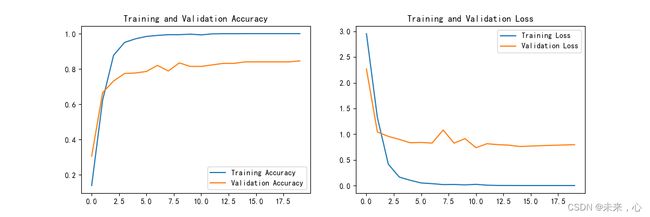深度学习CNN验证码识别

在以往发布的图像识别文章中,基本原理均差不多,这个主要是添加了新的知识,就是对标签数字化,从而实现对标签的数字化展示,
number = ['0', '1', '2', '3', '4', '5', '6', '7', '8', '9']
alphabet = ['a','b','c','d','e','f','g','h','i','j','k','l','m','n','o','p','q','r','s','t','u','v','w','x','y','z']
char_set = number + alphabet
char_set_len = len(char_set)
label_name_len = len(all_label_names[0])
# 将字符串数字化
def text2vec(text):
vector = np.zeros([label_name_len, char_set_len])
for i, c in enumerate(text):
idx = char_set.index(c)
vector[i][idx] = 1.0
return vector
all_labels = [text2vec(i) for i in all_label_names]
数据集来源
链接:https://pan.baidu.com/s/1ZX4tVslyAzjdqGklvBbYew
提取码:mdjn
数据集主要来源于灰度图像,如下图所示:
话不多说直接上代码
import tensorflow as tf
from PIL import Image
gpus = tf.config.list_physical_devices("GPU")
if gpus:
tf.config.experimental.set_memory_growth(gpus[0], True) #设置GPU显存用量按需使用
tf.config.set_visible_devices([gpus[0]],"GPU")
import matplotlib.pyplot as plt
# 支持中文
plt.rcParams['font.sans-serif'] = ['SimHei'] # 用来正常显示中文标签
plt.rcParams['axes.unicode_minus'] = False # 用来正常显示负号
import os,PIL,random,pathlib
# 设置随机种子尽可能使结果可以重现
import numpy as np
np.random.seed(1)
# 设置随机种子尽可能使结果可以重现
import tensorflow as tf
tf.random.set_seed(1)
data_dir = "H:\python_project\python辅助算法\data\captcha"
data_dir = pathlib.Path(data_dir)
all_image_paths = list(data_dir.glob('*'))
all_image_paths = [str(path) for path in all_image_paths]
# 打乱数据
random.shuffle(all_image_paths)
# 获取数据标签
all_label_names = [path.split("\\")[5].split(".")[0] for path in all_image_paths]
print(all_label_names)
image_count = len(all_image_paths)
print("图片总数为:",image_count)
plt.figure(figsize=(10, 5))
for i in range(20):
plt.subplot(5, 4, i + 1)
plt.xticks([])
plt.yticks([])
plt.grid(False)
# 显示图片
images = plt.imread(all_image_paths[i])
plt.imshow(images)
# 显示标签
plt.xlabel(all_label_names[i])
plt.show()
number = ['0', '1', '2', '3', '4', '5', '6', '7', '8', '9']
alphabet = ['a','b','c','d','e','f','g','h','i','j','k','l','m','n','o','p','q','r','s','t','u','v','w','x','y','z']
char_set = number + alphabet
char_set_len = len(char_set)
label_name_len = len(all_label_names[0])
# 将字符串数字化
def text2vec(text):
vector = np.zeros([label_name_len, char_set_len])
for i, c in enumerate(text):
idx = char_set.index(c)
vector[i][idx] = 1.0
return vector
all_labels = [text2vec(i) for i in all_label_names]
def preprocess_image(image):
image = tf.image.decode_jpeg(image, channels=1)
image = tf.image.resize(image, [50, 200])
return image/255.0
def load_and_preprocess_image(path):
image = tf.io.read_file(path)
return preprocess_image(image)
AUTOTUNE = tf.data.experimental.AUTOTUNE
path_ds = tf.data.Dataset.from_tensor_slices(all_image_paths)
image_ds = path_ds.map(load_and_preprocess_image, num_parallel_calls=AUTOTUNE)
label_ds = tf.data.Dataset.from_tensor_slices(all_labels)
image_label_ds = tf.data.Dataset.zip((image_ds, label_ds))
train_ds = image_label_ds.take(1000) # 前1000个batch
val_ds = image_label_ds.skip(1000) # 跳过前1000,选取后面的
BATCH_SIZE = 16
train_ds = train_ds.batch(BATCH_SIZE)
train_ds = train_ds.prefetch(buffer_size=AUTOTUNE)
val_ds = val_ds.batch(BATCH_SIZE)
val_ds = val_ds.prefetch(buffer_size=AUTOTUNE)
from tensorflow.keras import datasets, layers, models
model = models.Sequential([
layers.Conv2D(32, (3, 3), activation='relu', input_shape=(50, 200, 1)), # 卷积层1,卷积核3*3
layers.MaxPooling2D((2, 2)), # 池化层1,2*2采样
layers.Conv2D(64, (3, 3), activation='relu'), # 卷积层2,卷积核3*3
layers.MaxPooling2D((2, 2)), # 池化层2,2*2采样
layers.Flatten(), # Flatten层,连接卷积层与全连接层
layers.Dense(1000, activation='relu'), # 全连接层,特征进一步提取
layers.Dense(label_name_len * char_set_len),
layers.Reshape([label_name_len, char_set_len]),
layers.Softmax() # 输出层,输出预期结果
])
# 打印网络结构
model.summary()
model.compile(optimizer="adam",
loss='categorical_crossentropy',
metrics=['accuracy'])
epochs = 20
history = model.fit(
train_ds,
validation_data=val_ds,
epochs=epochs
)
acc = history.history['accuracy']
val_acc = history.history['val_accuracy']
loss = history.history['loss']
val_loss = history.history['val_loss']
epochs_range = range(epochs)
plt.figure(figsize=(12, 4))
plt.subplot(1, 2, 1)
plt.plot(epochs_range, acc, label='Training Accuracy')
plt.plot(epochs_range, val_acc, label='Validation Accuracy')
plt.legend(loc='lower right')
plt.title('Training and Validation Accuracy')
plt.subplot(1, 2, 2)
plt.plot(epochs_range, loss, label='Training Loss')
plt.plot(epochs_range, val_loss, label='Validation Loss')
plt.legend(loc='upper right')
plt.title('Training and Validation Loss')
plt.show()
# 保存模型
model.save('model/12_model.h5')
# 加载模型
new_model = tf.keras.models.load_model('model/12_model.h5')
def vec2text(vec):
"""
还原标签(向量->字符串)
"""
text = []
for i, c in enumerate(vec):
text.append(char_set[c])
return "".join(text)
plt.figure(figsize=(10, 8)) # 图形的宽为10高为8
import cv2
for images, labels in val_ds.take(1):
for i in range(6):
ax = plt.subplot(5, 2, i + 1)
# 显示图片
# image = tf.image.decode_jpeg(images[i], channels=3)
# plt.imshow(Image.fromarray(np.array(images[i])))
cv2.imshow("aa",np.array(images[i]*255))
cv2.waitKey()
# 需要给图片增加一个维度
img_array = tf.expand_dims(images[i], 0)
# 使用模型预测验证码
predictions = new_model.predict(img_array)
print(vec2text(np.argmax(predictions, axis=2)[0]))
下面给出训练结果:

输出结果

本次验证码识别主要是根据这篇文章(深度学习100例-卷积神经网络(CNN)识别验证码 | 第12天)